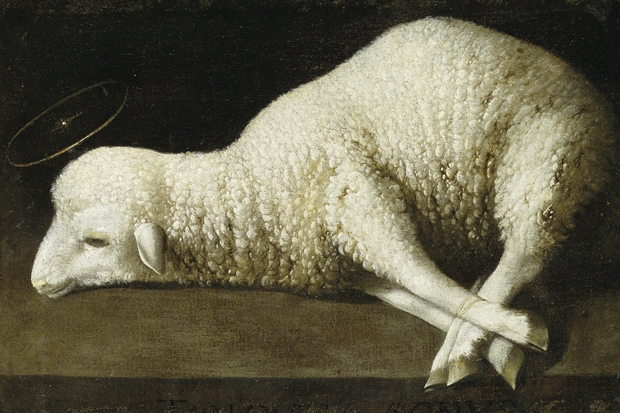It seems suitable that just round the corner from the Zurbarán exhibition at the Palais des Beaux Arts is the Musée Magritte. Surrealism was in the air of 20th-century Belgium, just as much as it was in the atmosphere of Spain. And of course in many cases its leading figures — Buñuel, Dalí, René Magritte — were lapsed Catholics. Francisco de Zurbarán (1598–1664), in contrast, was one of the most striking examples in art history of the unlapsed Catholic. His paintings express the faith of the Spanish counter-reformation at full strength, but the results are often as disconcerting in their way as a painting of baguettes raining down from the sky.
In Zurbarán’s world, however, there are more likely to be showers of roses than of bread. Pink and white blooms have obviously just fluttered down on St Francis in the ‘Miracle of Portiuncula’ (c.1630–1). They are carefully arranged at regular intervals on the steps around Francis, who raises his eyes to the vision above in which Christ and the Virgin have appeared to present him with an indulgence.
As is usually the case with Zurbarán, it’s not the sacred beings occupying the golden clouds above who seem wonderful and strange, it’s the saint with his heavy habit and wrinkled brow, and those roses so carefully arranged around him. In other words, it was Zurbarán’s meticulous depiction of the natural that gives his pictures such bizarre punch.
Art historically, Zurbarán belongs to the aftermath of Caravaggio, whose influence rapidly flooded Europe in the early 17th century. The Italian painter used what David Hockney has called ‘Hollywood lighting’ — deep shadows, spot-lit highlights — to give unprecedented drama, realism and emotional impact to religious art. Zurbarán used the same devices to make the most ordinary objects — a vase, a piece of cloth — appear supernatural.
In origin Zurbarán was an outsider, born in a little village in Estremadura, his father a shopkeeper. He was nearing 30 when he produced the first works in this exhibition. After that he flourished for over a decade, then drifted out of fashion. He died, poor and half-forgotten in Madrid, leaving the ‘few possessions we have’ to his third wife (he was twice a widower).
Zurbarán’s training as an artist was evidently patchy. Aspects of his technique always remained uncertain. There is wonky foreshortening and awkward composition even in some of his finest works. But that just adds to their appealing strangeness. Or at least sometimes it does. There are strange fluctuations of style and quality in this show, with mediocre and even ugly pictures among the masterpieces — perhaps these were done by his workshop, although one begins to wonder whether Zurbarán himself wasn’t eccentrically erratic. At his greatest, however — and there are many tremendous paintings on display in Brussels — Zurbarán was a supreme exponent of the everyday made extraordinary.
‘The Veil of St Veronica’ (c.1630–5) represents the piece of cloth on which Christ’s image miraculously appeared when the saint wiped the blood and sweat from his face on the road to Calvary. But what gives Zurbarán’s interpretation of the legend a frisson is the mesmerising realism with which he painted the cream-coloured textile, apparently suspended by strings in front of your eyes, each thick fold and rumple is caressed by light. The fabric is so palpably real that the ghostly face in the middle is believable too.
Zurbarán excelled, too, at the wool of his ‘Agnus Dei’ (c.1635–40), a picture in which the metaphor ‘Lamb of God’ seems to have come to life. The poor little animal is lying passive and bound on a shelf like a piece of meat (I once saw a live lamb in just such an Easter display in a Milan butcher’s shop).
As this picture might suggest, Zurbarán excelled at what the Italians call ‘natura morta’: still life. Bread, though he did not paint it falling from the sky, was a speciality. ‘Asher’, one of his paintings of Jacob and his Twelve Sons from Auckland Castle, is holding a magnificent basket of crusty rolls.
The exhibition in Brussels has one of the best of Zurbarán’s rare paintings of still life alone (rather than included in a larger composition). ‘Still Life with Jars’ (c.1558–64) consists of a row of vessels — three ceramic, one metal — set out as if on a shelf. They are ordinary enough jugs and vases, but somehow they have the feeling of an apparition. That, you might say, was the Zurbarán effect. It’s well worth a trip on Eurostar to experience it.






Comments